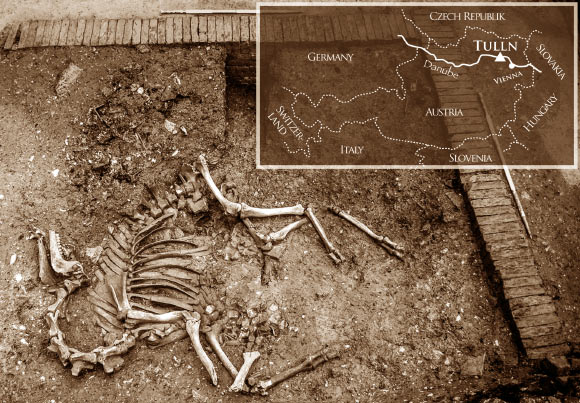A group of archaeologists led by Dr Alfred Galik of the University of Veterinary Medicine Vienna has found a complete camel skeleton in a large refuse pit in Tulln, Austria, dating back to the time of the Ottoman-Habsburg wars.

In situ view of the 17th century camel; inserted map shows the geographical position of the town Tulln in Austria with a triangle. Image credit: Galik A et al.
“The partly excavated skeleton was at first suspected to be a large horse or cattle. But one look at the cervical vertebrae, the lower jaw and the metacarpal bones immediately revealed that this was a camel,” said Dr Galik, who is the first author of the paper published in the journal PLoS ONE.
Camel bones have been found in Europe dating back to the Roman period. Isolated bones or incomplete skeletons are known from Mauerbach near Vienna as well as from Serbia and Belgium. But a complete camel skeleton is unique for Central Europe.
Dr Galik and his colleagues from Austria performed extensive anatomical and morphometrical analyses and showed that the Tulln camel was male and a hybrid: its mother was a dromedary (Camelus dromedarius), and its father a Bactrian camel (Camelus bactrianus).
“Such crossbreeding was not unusual at the time. Hybrids were easier to handle, more enduring, and larger than their parents. These animals were especially suited for military use,” Dr Galik said.
“The two species (dromedary and Bactrian camel) are able to interbreed, which results in larger, more powerful and efficient hybrid offspring. Crossbreeding probably took first place in Assyria at the beginning of the 1st millennium BC and this technique continued over Antiquity towards the modern times. Hybridization was improved as the Arabs went into Iran and Central Asia,” the scientists wrote in the paper.
“Obviously, such hybrids were of great importance in the Ottoman troops mainly for transportation but also as riding animals. The first appearance of a camelry, soldiers fighting with bows on camelback, had been recorded during the invasion of Xerxes in Greece 481 BC.”
“Today, hybridization facilitates improved milk and wool yield in hybrid Tulu or Nar camels from Middle Eastern and Central Asian countries. Commonly, two hybridizing methods are recognized, Kurt-nar (dromedary female x Bactrian male) and Kez-nar (Bactrian female x dromedary male) followed by F1-backcrossing with either dromedary for increased milk productivity or Bactrian camel for a higher wool yield and cold resistance.”
The Ottoman army used horses as well as camels for transportation and as riding animals.
In cases of scarcity, the soldiers also ate the animal’s flesh; however, the Tulln skeleton was complete.
“This means that the animal was not killed and then butchered. It may have been acquired as part of an exchange,” Dr Galik explained.
“Besides animal bones, the excavations also unearthed ceramic plates and other items.”
“A coin – a so-called Rechenpfenning – from the time of Louis XIV dates the find to the years between 1643 and 1715.”
“A medicinal bottle containing Theriacum, a medieval remedy from the chemist’s shop ‘Apotheke zur Goldenen Krone’ in Vienna was also found at the site. This pharmacy existed between 1628 and 1665, which helped date the site with further precision.”
_____
Galik A et al. 2015. A Sunken Ship of the Desert at the River Danube in Tulln, Austria. PLoS ONE 10 (4): e0121235; doi: 10.1371/journal.pone.0121235







